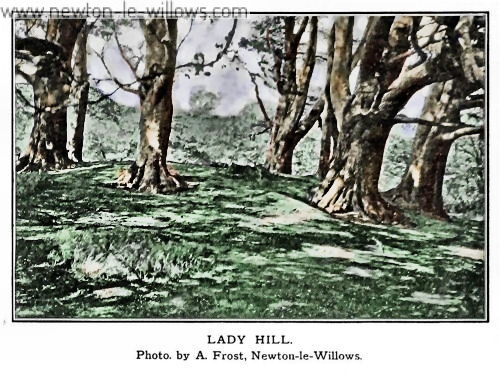I noted that some questions have been asked about Lady Hill, a barrow or not a barrow? good question, I do not think its ever been investigated, The Rev Simpson conducted an investigation into the Castle Hill barrow/mound in the 1840s and it was also investigated in the c1988, but as far as I can discover, no investigations have been done on the the nearby Lady Hill mound.
I have transcribed the following from the 1916 Vol II, J H Lane book on Newton. Its a description of the walk from Haydock Park along the Dean Valley, Past Dean Dam, Lady Hill, Castle Hill and on towards Newton Lake Dam, and County Bridge.
On we go along the road skirting the valley, now, in this sunny month of June, so redolent of flower and shrub, so eye-refreshing with varied shades of green, and so ear-delighting with melodies of bird and bee and stream, and arrive at the entrance to the slope leading to the foot-bridge over the brook. Did ever streamlet flow through more delightful scenery ? This year the rhododendrons have been most prolific in bloom and radiant in colour, and, at the meeting of the waters from Hay-clock, Ashton, and Colborne, the reeds and rushes seen of a livelier green than heretofore. We linger on the bridge and scat the water below, but no longer see the small fry steadying themselves against the stream as in days gone by. From this point we obtain a good view of the valley and the varied trees that line its banks. We cross the brook, turn down the path to look into the Wishing Well, and thence pursue our way to Dean Dam, passing the spot where once stood two cottages, one tenanted by “Jucco” Legit, the thatcher. He, like so many more we knew in boyhood, has emigrated to the “Land of the Hereafter,” the cottage he inhabited has long ago been demolished, and where, once the gardens smiled a swampy waste is seen. We mount the crooked path to the dam-head, and note the bank of blooming rhododendrons and background of tall trees reflected in the water, and the lilies in the dam showing their white buds above their round floating leaves.
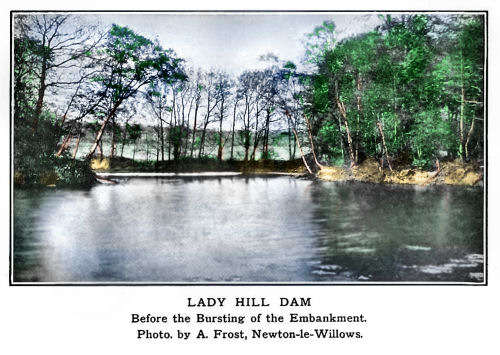
We climb the slope, and, seeing the keeper, ask permission to accompany him on his morning round. We pass the farm-house occupied by Mr. David Garton, and note the large fields on the right, in which the celebrated seed specialists, Garton Brothers, made their interesting and valuable experiments in grass and corn cross-fertilization. Soon we reach the wood, and, keeping to the winding path, look admiringly at the giant boles of century-old beeches, chestnuts, and other trees. In a short time we arrive at Lady Hill, a bowl barrow some six or seven feet in height and 160 feet in circumference?half the circumference of Castle Hill. Around its rim are eight mighty beeches with long boughs stretching parallel with the ground and with tops towering above those of the adjacent trees. Originally there seems to have been twelve beeches upon the hill; and, in gazing upon the mound and the trees, we wonder for what purposes the former was raised and the latter were planted. The mound could hardly have been made for a mili?tary outlook or for interments, as its height is probably little less now than formerly, though its position at the top of the Dean Valley and Castle Hill at the bottom would suggest some connection between the two. We have seen, in the Rev. E. Sibsons account of the opening of Castle Hill, the story of the discovery of a curious interment therein, and of his inference that the hill was used for Druid worship. Could Lady Hill have been used for a similar purpose ? We learn that the Druids were astronomers and worshipped the sun and the moon. Was the larger hill constructed for sun worship and the smaller for moon worship ? If so, we might find a reason for the name Lady Hill.
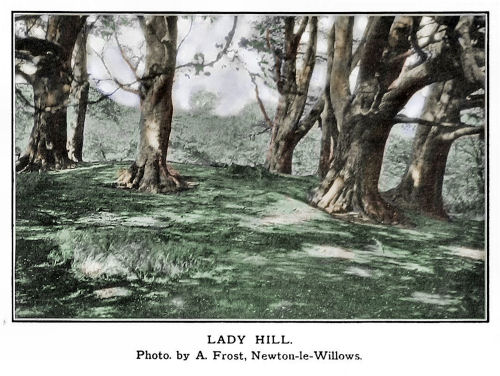
Photo from the 1916 J H Lane, History of Newton Book
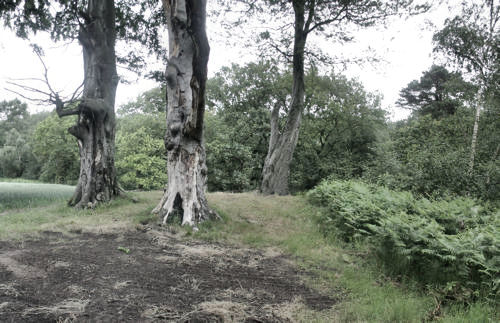
Recent Photo of Lady Hill, by Steven Dowd
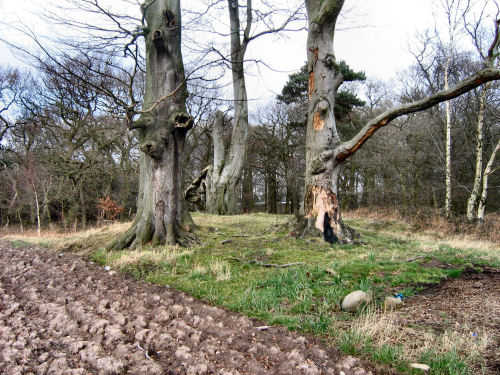
Recent Photo of Lady Hill, by Bob Hayes
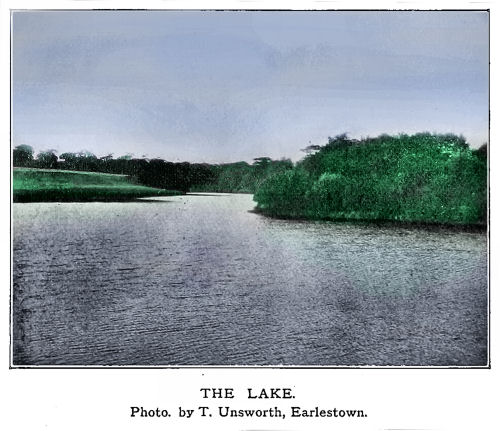
c1916 photo of Newton Lake,a much largerarea of clear water than it is in 2005
NOTES ON ” ROB LANE,” and ” LADY HILL,” &c., BY Peter Mayor Campbell.
Seeing that the word “Sankey” is derived from the Sabine language, it seems reasonable to suppose that the words ” Rob Lane” may also be the germs of Sabine words, being found so near to the source of the Sankey and the Dene. And on examination we find that this is so, for ” Rob” is the root or radix of Robigo, the Sabine deity that presides over the ceri and flora?Ceres (the goddess of corn) and Flora (the goddess of flowers), for the same people who worshipped the hero Hercules wor?shipped the goddess Robigus in a festival called Robigalia and Rubigalia, instituted at Rome (in honour of the god Robigus for the preservation of the corn from mildew) by Numa Pounpilius in the eleventh year of his curia (a ward), and celebrated on the seventh of May (25th April of the Julian calendar, following the sun). He reigned forty years, and was Curia of the Sabines (one of the thirty parts into which Romulus divided the Roman people), and contemporary with the threatening of the Jews by the prophet Jeremiah
“Seest thou not what they do in the cities of Judah and in the streets of Jerusalem ? The children gather wood, and the fathers kindle the fire, and the women knead their dough, to make cakes to the queen of heaven, and to pour out drink offerings unto other gods, that they may provoke me to anger. Do they provoke me to anger? saith the Lord: do they not provoke themselves to the confusion of their own faces ? ” vii. 17-20.
Luna is in perigee (that is, the moon is nearest to the earth) on that day, and she was their “queen” or “lady.” Other great ladies were Amata, de Venere, Juno, Diana, and Silvestris (Bacchantiam). There was also a Gladiatoria Venus, and, under colour of the goddess Robigo and Robigalia, was a Robigiuem being ; according to Servius and Varro, an obscene and libidinous life born of abundance and superfluity of blood, and by the Greeks called Saturnalia.
Roboretum, Robus, Robos, and Robusteus are derivatives of Robins and Robur. Saturn was the tutelary father of the Sabines, who are often referred to in the earlier Latin authors as Samnis, Saninites, Sabellicus, Sabellus, Sabini, from Saumiuun in the Abruzzi. Their chief city was Cures. They were accounted a very ferocious people, and supplied most of the gladiators?sanguis Sabini.
There was also a Roman Cerealia, a festival in honour of Ceres, as there was a Florialia, a festival or games in honour of Flora, where gladiators, and trainers of gladiators, fencing masters, displayed their skill and daring in the arena, which may have been a Gladiatorius ludus as well as a Spectaculum, a show or exhibition of gladiators. According to Cato and Severus, they were, in Apulia, a colony of Lacedemonians, and so here also the Greek element prevailed, and it is quite within the bounds of possibility that the Greek traveller, Pythmus (B.C. 330), met them; for the name and position of the Lady Hill at the head of the Dene valley point to the conclusion that that leas a civil and religious centre, as the Castle Hill was a military centre, and that the worship of Baal centred at the Aerolite at the other end of Rob-lane. Moreover, the Druidm (the priests of Britain and Gaul) were magicians and philosophers, and understood astronomy as known to the Greeks (Druidai), and nearly all the records of the Greek traveller, Pythteus, consist of astronomical observations gathered in Britain.
“Lane” is the root of the word Lanio (a butcher) and Lauio (to cut like a butcher, to tear or cut in pieces, cut up, lacerate, laniate), and Lanisla (a teacher or trainer of gladiators). Gladiator signifies a sword-cutler, sword-player, prize-fighter. Lanista (de gallis gallinaeei.$) signifies also a cock-master. The names of roads among the Rowans were, first, a foot-way, which is ire?. (quod est jus eundi eel ambulandi hominis), and this was the first way. The second is a foot-way and horse-way, which is called act us ab agendo, and this is vulgarly called pack- and prime-way, because it is both a foot-way, which was the first or prince-way, and a pack- or dr ft-way also. The third is via or aditu.s, which contains the other two, and also a cart-way, etc., for this is jus eundi vehendi, et rehicu?lum et jumentum ducendi; and this is twofold, viz., regio via, the kings highway for all men (the Wigan-Warrington road), et cosnmaui.s strata, belonging to a city or town, or between neighbours and neighbours (Haydock and Lowton via Castle Hill) and pontus over the Sankey.
This is called in our books chemin, being a French word for a way, whence is derived chiminage, chiminingium, or ctimmaginm, which signifies a toll due by custom for having a way through a forest ; and in ancient records is sometimes also called pedagium. This quarter of the town, if it had been intended for the name of a street, would have been called Laura, which is the name of a “lane” in Greek, which the Sabines spoke. It was, however, actus ab agendo (understood but not named), “a road between fields for beasts, etc., to pass from and go to” (the Robigalia and the Lanista). The meaning was lost with the terminations “galia” and “sta”; the”Robi” became “Robe” and then ” Rob,” and the “Lani” became “Lane” in the 18th century and till to-day. “Lane” (a way between hedges) is Anglo-Saxon, and does not appear before A.D. 449, when the invaders came. Of they had a tendency to abbreviate.
Transcribed by Steven Dowd from the 1916 Vol II, History of Newton in Makerfield by J H Lane.
